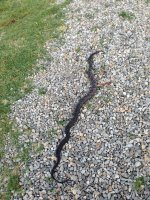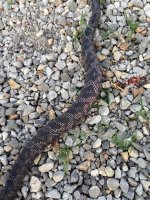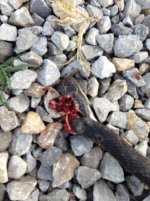Actually, the hognose snake is venomous, just not dangerously so. Here's an excerpt from a web page about them.
</font><font color="blue" class="small">( Hognose snakes are opisthoglyphous (having fangs at the back of the mouth) and they use this feature to deflate toads which may puff themselves up with air to unswallowable proportions. I mentioned previously these snakes were nonvenomous, but there is some evidence that they may be mildly venomous (LeClere, 1996). Although there have been many cases of Heterodon envenomation, its toxicity is controversial. McAlister (1963) took extract from the salivary glands of H. platyrhinos and injected white mice, spring peepers, Pseudacris crucifer, Fowlers toads, Bufo woodhousei fowleri, and chorus frogs, Pseudacris triseriata, in the thighs. The mice were unaffected. Fifteen of the seventeen amphibians died within two days. Subcutaneous hemorrhage, edema, and inflammation led McAlister to conclude that the venom is hemotoxic. Other authors have concurred that this genera of snakes is venomous; others discount it. Anderson tried several times to induce a H. platyrhinos to envenomate him. He even made an extract and administered it to himself. It produced nothing more than slight burning. )</font>
Frogs and toads are the hognose snake's favorite meal. I find them fairly frequently around my dad's pond which has a healthy frog/toad population.
</font><font color="blue" class="small">( Hognose snakes are opisthoglyphous (having fangs at the back of the mouth) and they use this feature to deflate toads which may puff themselves up with air to unswallowable proportions. I mentioned previously these snakes were nonvenomous, but there is some evidence that they may be mildly venomous (LeClere, 1996). Although there have been many cases of Heterodon envenomation, its toxicity is controversial. McAlister (1963) took extract from the salivary glands of H. platyrhinos and injected white mice, spring peepers, Pseudacris crucifer, Fowlers toads, Bufo woodhousei fowleri, and chorus frogs, Pseudacris triseriata, in the thighs. The mice were unaffected. Fifteen of the seventeen amphibians died within two days. Subcutaneous hemorrhage, edema, and inflammation led McAlister to conclude that the venom is hemotoxic. Other authors have concurred that this genera of snakes is venomous; others discount it. Anderson tried several times to induce a H. platyrhinos to envenomate him. He even made an extract and administered it to himself. It produced nothing more than slight burning. )</font>
Frogs and toads are the hognose snake's favorite meal. I find them fairly frequently around my dad's pond which has a healthy frog/toad population.



